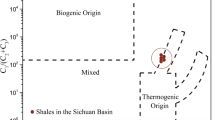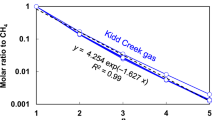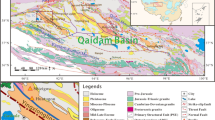Abstract
ALTHOUGH methane of bacterial origin is ubiquitous in marine and freshwater sediments, economic accumulations of bacterial gases occur mainly at depths of several kilometres in Tertiary basins that had high sedimentation rates1,2. Here we present an integration of geochemical and isotopic data from gas and water extracted from the Upper Devonian Antrim shale, along the northern margin of the Michigan basin, which demonstrates that significant volumes of bacterial gas have been generated in organic-rich shales at depths of less than 600 metres. The Antrim shale is mainly a self-sourced reservoir, in contrast to conventional gas deposits that have migrated from a source to a reservoir, and has become one of the most actively exploited gas reservoirs3 in the United States. The gas-forming processes operating at shallow depths in the Antrim shale are not unique4, and an understanding of these processes should lead to the identification and development of other economic, non-conventional gas deposits around the world.
This is a preview of subscription content, access via your institution
Access options
Subscribe to this journal
Receive 51 print issues and online access
$199.00 per year
only $3.90 per issue
Buy this article
- Purchase on Springer Link
- Instant access to full article PDF
Prices may be subject to local taxes which are calculated during checkout
Similar content being viewed by others
References
Mattavelli, L., Ricchiuto, T., Grignani, D. & Schoell, M. Bull. Am. Assoc. Petrol Geol. 67, 2239–2254 (1983).
Rice, D. D. Gulf Coast Assoc. Geol. Soc. Trans. 30, 203–213 (1980).
Scott, A. R., Kaiser, W. R. & Ayers, W. B. Bull. Am. Assoc. Petrol. Geol. 78, 1186–1209 (1994).
Frantz, J. GasTIPS 2, 5–11 (1995/96).
Rullkötter, J., Marzi, R. & Meyers, P. A. in Early Organic Evolution: Implications for Mineral and Energy Resources (eds Schidlowski, M. et al.) 324–335 (Springer, Heidelberg, 1992).
Farrand, W. R. & Eschman, D. F. Michigan Academician 7, 31–56 (1974).
Bahr, J. M., Moline, G. R. & Nadon, G. A. Mem. Am. Assoc. Petrol. Geol. 61, 153–165 (1994).
Apotria, T. G., Kaiser, C. J. & Cain, B. A. in Rock Mechanics (eds Nelson, P. P. and Lauback, S. E.) 809–816 (Balkema, Rotterdam, 1994).
Walter, L. M. et al. Hydrogeochemistry of the Antrim Shale, Northern Michigan Basin (Annual. Rep., Gas Res. Inst., Chicago, 1996).
Vugrinovich, R. J. Petrol. Geol. 11, 429–442 (1988).
Dellapenna, T. M. thesis, Western Michigan Univ., Kalamazoo (1991).
Balabane, M., Galimov, E., Hermann, M. & Letolle, R. Org. Geochem. 11, 115–119 (1987).
Jenden, P. D., Newell, K. D., Kaplan, I. R. & Watney, W. L. Chem. Geol. 71, 117–147 (1988).
Coleman, D. D., Liu, C. L. & Riley, K. M. Chem. Geol. 71, 23–40 (1988).
Fuex, A. N. J. Geochem. Explor. 7, 155–188 (1977).
Schoell, M. Geochim. Cosmochim. Acta 44, 649–661 (1980).
Woltemate, I., Whiticar, M. J. & Schoell, M. Limnol. Oceanogr. 29, 985–992 (1984).
Whiticar, M. J., Faber, E. & Schoell, M. Geochim. Cosmochim. Acta 50, 693–709 (1986).
Nakai, N., Yoshida, Y. & Ando, N. Chikyu Kagaku 7, 87–98 (1974).
Vary, J. A., Elenbaas, J. R. & Johnson, M. A. in Natural Gases of North America 1761–1797 (Amer. Assoc. Petroleum Geologists, Tulsa, Oklahoma, 1968).
Schoell, M. J. Geol. Soc. Lond. 140, 415–422 (1983).
Prinzhofer, A. A. & Huc, A. Y. Chem. Geol. 126, 281–290 (1995).
Coleman, D. D., Liu, C., Hackley, K. C. & Pelphrey, S. R. Eviron. Geosci. 2, 95–103 (1995).
Bernard, B. B., Brooks, J. M. & Sackett, W. M. J. Geophys. Res. 83, 4053–4061 (1978).
Stetter, K. O. et al. Nature 365, 743–745 (1993).
Stevens, T. O. & McKinley, J. P. Science 270, 450–453 (1995).
Rice, D. D. in Hydrocarbons from Coal (eds Law, B. E. & Rice, D. D.) 159–184 (Amer. Assoc. Petroleum Geologists, Tulsa, Oklahoma, 1993).
Venneman, T. W. & O'Neil, J. R. Chem. Geol. 103, 227–234 (1993).
Schoell, M., Jenden, P. D., Beeunas, M. A., Coleman, D. D. Gas Technology Symp. 337–344 (Soc. Petroleum Engineers, Calgary, 1993).
Author information
Authors and Affiliations
Rights and permissions
About this article
Cite this article
Martini, A., Budai, J., Walter, L. et al. Microbial generation of economic accumulations of methane within a shallow organic-rich shale. Nature 383, 155–158 (1996). https://doi.org/10.1038/383155a0
Received:
Accepted:
Issue Date:
DOI: https://doi.org/10.1038/383155a0
This article is cited by
-
Geochemical characteristics and origins of hydrocarbon gases in the shallow gas field in the Pohang Basin, Korea
Geosciences Journal (2022)
-
A geochemical and isotopic assessment of hydraulic connectivity of a stacked aquifer system in the Lisbon Valley, Utah (USA), and critical evaluation of environmental tracers
Hydrogeology Journal (2021)
-
Timing and origin of natural gas accumulation in the Siljan impact structure, Sweden
Nature Communications (2019)
-
Hydrogen and carbon isotope systematics in hydrogenotrophic methanogenesis under H2-limited and H2-enriched conditions: implications for the origin of methane and its isotopic diagnosis
Progress in Earth and Planetary Science (2016)
-
Hydrocarbon potential and porosity types of the Geli Khana Formation (Middle Triassic), Northern Iraq
Arabian Journal of Geosciences (2015)
Comments
By submitting a comment you agree to abide by our Terms and Community Guidelines. If you find something abusive or that does not comply with our terms or guidelines please flag it as inappropriate.



